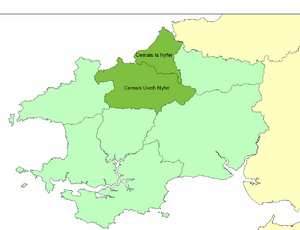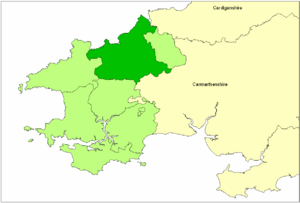Cemais (Dyfed) facts for kids
Cemais (also known as Kemes) was an important area in Wales. It started as an ancient cantref (a large land division) within the Kingdom of Dyfed. Later, in the 11th century, it became a Marcher Lordship ruled by the Normans.
By the 16th century, Cemais was known as a Hundred, which was a way to divide counties. Today, it is part of Pembrokeshire, Wales.
Cemais was located along the coast between the Teifi River and Fishguard. It also included the northern and southern parts of the Preseli Hills. This area covered about 140 square miles (360 square kilometers). The Afon Nyfer river split Cemais into two smaller parts called commotes: Cemais Is Nyfer in the north and Cemais Uwch Nyfer in the south.
Contents
History of Cemais
Early Welsh Rule
Cemais was once part of a larger Welsh kingdom called Deheubarth. In the mid-11th century, Rhys ap Tewdwr ruled Deheubarth. He had agreed to be loyal to William the Conqueror, the Norman King of England.
When William the Conqueror died in 1087, Rhys ap Tewdwr felt he was no longer bound by his promise. He joined a rebellion and was later killed in battle. After his death, his lands, including Cemais, were taken by Norman lords.
Norman Arrival in the 11th Century
Around 1094, a Norman knight named Martin de Turribus sailed from Devon, England, to Fishguard. He fought against the local people and took control of most of northern coastal Dyfed. These lands became the Marcher Lordship of Kemes.
Martin de Turribus chose Nevern as his main base and built a castle there to protect it. Even under Norman rule, the people of Kemes mostly continued to speak Welsh.
Changes in the 12th Century
After King Henry I died in 1135, there was a period of great disorder in England. A Welsh leader named Gruffydd ap Rhys used this chance to rebuild the kingdom of Deheubarth. By 1136, Gruffydd had conquered many areas, including Cemais, and the Norman ruler, Robert fitz Martin, was forced out.
Later, Robert's son, William Fitz Martin, got Kemes back. He received it as a gift when he married Angharad, a daughter of Rhys ap Gruffydd, another powerful Welsh prince.
In 1191, Rhys ap Gruffydd took Cemais from William Fitz-Martin and gave it to his own son, Gruffydd ap Rhys II. However, Rhys had an older son, Maelgwn ap Rhys, who was a rival. Maelgwn attacked Cemais and even imprisoned his father, Rhys, in Nevern castle.
When Rhys died in 1197, a war broke out between Maelgwn and Gruffydd. During this time, William fitz Martin managed to regain control of Kemes. He then established a new main base at Newport.
Cemais in the 13th Century
The Fitz-Martin family continued to hold Cemais throughout the 13th century. Even when powerful Welsh princes like Llywelyn Fawr (in 1215) and his grandson Llywelyn ap Gruffudd (in 1257) captured Cemais, the Fitz-Martins always managed to get it back.
In 1326, the last Lord Martin died without children. The Lordship of Cemais then passed to his sister, Joan, and her husband, James Audley. The Audley family held Cemais until 1497. At that time, the 7th Baron Audley rebelled against King Henry VII. He failed and was executed, and his lands were taken by the King.
Cemais Becomes a Hundred in the 16th Century
In 1534, King Henry VIII gave the lands of Cemais back to John Tuchet, the 8th Baron Audley. However, Henry VIII was already planning to change how these Marcher Lordships worked.
In 1535, the first of the Laws in Wales Acts officially ended the special status of Marcher Lordships. The former Marcher Lordship of Cemais, along with other nearby areas, became part of the new county of Pembrokeshire.
Pembrokeshire was then divided into smaller administrative areas called Hundreds. Most of the old Cemais area became the new Hundred named Cemais. A small part of the old Cemais became part of the Cilgerran Hundred.
In 1536, John Tuchet sold the barony of Cemais to a local lawyer named William Owen. William Owen's son, George Owen, took over in 1574. George Owen was very interested in history and wrote detailed descriptions of the area, including the boundaries of the Cemais Hundred.
See also



